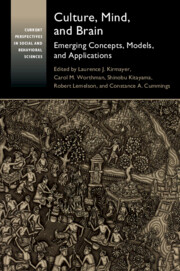Book contents
- Culture, Mind, and Brain
- Current Perspectives in Social and Behavioral Sciences
- Culture, Mind, and Brain
- Copyright page
- Dedication
- Epigraph
- Contents
- Figures
- Tables
- Contributors
- Preface
- Abbreviations
- 1 Introduction
- Part I Dynamics of Culture, Mind, and Brain
- Section 1 The Co-emergence of Culture, Mind, and Brain
- 2 Culture, Mind, and Brain in Human Evolution
- 3 Mutual Constitution of Culture and the Mind
- 4 Being There
- Section 2 The Situated Brain
- Section 3 How Social Coordination and Cooperation are Achieved
- Part II Applications
- Index
- References
4 - Being There
Foundations, Theory, Method
from Section 1 - The Co-emergence of Culture, Mind, and Brain
Published online by Cambridge University Press: 18 September 2020
- Culture, Mind, and Brain
- Current Perspectives in Social and Behavioral Sciences
- Culture, Mind, and Brain
- Copyright page
- Dedication
- Epigraph
- Contents
- Figures
- Tables
- Contributors
- Preface
- Abbreviations
- 1 Introduction
- Part I Dynamics of Culture, Mind, and Brain
- Section 1 The Co-emergence of Culture, Mind, and Brain
- 2 Culture, Mind, and Brain in Human Evolution
- 3 Mutual Constitution of Culture and the Mind
- 4 Being There
- Section 2 The Situated Brain
- Section 3 How Social Coordination and Cooperation are Achieved
- Part II Applications
- Index
- References
Summary
This chapter explores dual senses of “being there,” as existential fact and corollary method, and suggests some reasons why and how an ecological framework provides an effective approach to unpacking the culture–mind–brain nexus. First, an ecological analysis brings the lens of evolutionary design to bear on human biology (brain), function (mind), and behavior (culture). Second, it taps reliance of developmental processes on nested timelines of interaction with context that drive physical (body/brain), functional (mind), and behavioral (enculturation) development across the life course. Third, it hones in on conditions created by humans’ reliance on culture, thereby creating their own ecologies that, in turn, generate tremendous human diversity. Being there can also play a valuable research role. Three case studies explore that role in interaction with existing bodies of knowledge, major societal and scientific questions, and studies with novel human cultures and ecologies. They also sketch an arc of inquiry that integrates biomarkers and health outcomes with measures of psychosocial dynamics and life course development into population research embedded in community and cultural settings. A dialectical ecologically informed approach that fluidly deploys diverse modes of research may be particularly effective for tackling the large questions and challenges that humans confront.
Keywords
- Type
- Chapter
- Information
- Culture, Mind, and BrainEmerging Concepts, Models, and Applications, pp. 120 - 158Publisher: Cambridge University PressPrint publication year: 2020



